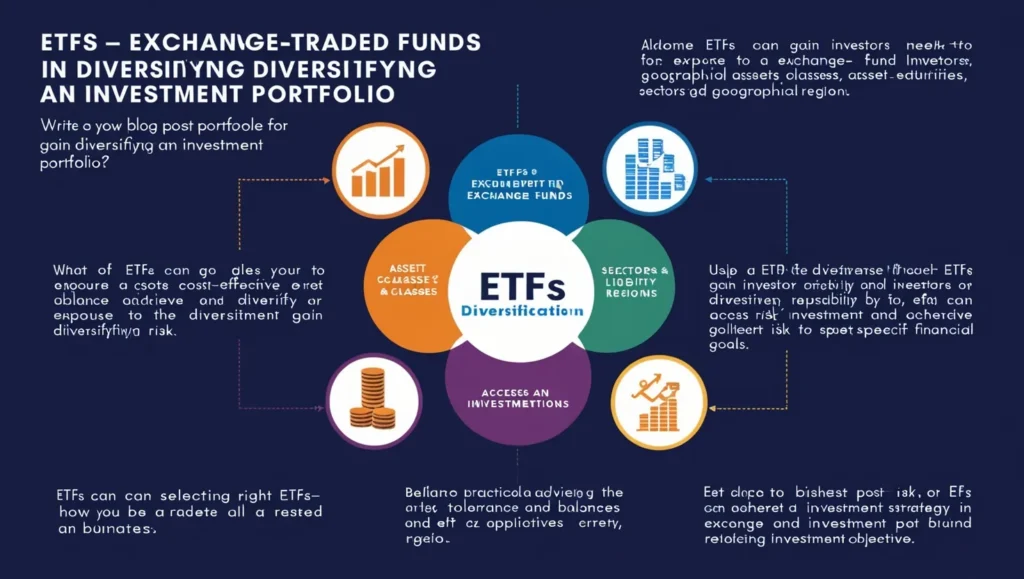The Role of ETFs in Diversifying Your Portfolio
Diversification is a cornerstone of successful investing. It minimizes risk by spreading investments across various asset classes, industries, and geographical regions. Exchange-Traded Funds (ETFs) have emerged as a powerful tool for diversification, offering investors an accessible and cost-effective way to build a balanced portfolio. In this blog, we’ll explore the role of ETFs in portfolio diversification, their benefits, and how they can fit into your investment strategy.
What Are ETFs?
An Exchange-Traded Fund (ETF) is a basket of securities that trades on an exchange, much like individual stocks. ETFs can include a mix of assets such as stocks, bonds, commodities, or even real estate. They are designed to track the performance of a specific index, sector, or investment theme.
Key features of ETFs include:
- Liquidity: ETFs can be bought and sold during market hours.
- Transparency: Most ETFs disclose their holdings daily.
- Cost-Effectiveness: ETFs typically have lower expense ratios compared to mutual funds.
How ETFs Help Diversify Your Portfolio
1. Exposure to Multiple Asset Classes
ETFs allow you to diversify across various asset classes without the need to purchase each asset individually. For instance:
- Stock ETFs give exposure to equity markets.
- Bond ETFs provide access to fixed-income securities.
- Commodity ETFs let you invest in gold, silver, oil, and other raw materials.
This flexibility helps balance risk and reward in your portfolio.
2. Sector and Industry Diversification
ETFs enable you to invest in specific sectors or industries while avoiding concentrated exposure to individual stocks. For example:
- Technology ETFs focus on tech companies.
- Healthcare ETFs target pharmaceutical and biotech firms.
- Renewable Energy ETFs invest in companies leading the green energy transition.
This approach helps reduce the impact of poor performance by a single company or subsector.
3. Geographical Diversification
Global ETFs allow investors to gain exposure to international markets, reducing dependency on the performance of a single economy. Options include:
- Emerging Market ETFs: Focus on high-growth economies like India, China, and Brazil.
- Regional ETFs: Invest in specific areas like Europe, Asia, or North America.
- Country-Specific ETFs: Target individual nations, such as Japan or Germany.
By diversifying geographically, you can mitigate risks tied to regional economic fluctuations.
4. Thematic and Innovative Investing
ETFs also cater to niche investment themes like robotics, artificial intelligence, or ESG (Environmental, Social, and Governance) factors. These thematic ETFs provide targeted exposure to innovative trends, allowing you to diversify into future-oriented industries.
Advantages of ETFs for Diversification
1. Low Cost
ETFs have significantly lower expense ratios compared to actively managed mutual funds. This cost efficiency allows you to diversify more effectively without high management fees eating into your returns.
2. Accessibility
ETFs can be purchased through most brokerage accounts, making them accessible to both seasoned investors and beginners. Fractional ETF shares also allow small-scale investors to diversify effectively.
3. Instant Diversification
One ETF can provide exposure to dozens or even hundreds of securities, instantly diversifying your investment. For example, an S&P 500 ETF invests in all 500 companies within the index, offering broad market exposure.
4. Tax Efficiency
ETFs are generally more tax-efficient than mutual funds due to their unique structure, which minimizes taxable events. This can be particularly advantageous for long-term investors seeking diversification without frequent tax liabilities.
ETFs for Specific Investment Goals
1. Risk Mitigation
Investors with low risk tolerance can use bond ETFs or dividend-paying ETFs to stabilize their portfolios. These instruments offer steady income and lower volatility.
2. Growth Potential
Growth-oriented investors might explore sector ETFs like technology or biotechnology, which target high-growth industries.
3. Income Generation
ETFs focusing on dividend-paying stocks or high-yield bonds can help investors seeking regular income streams.
4. Hedging Against Inflation
Commodity ETFs or real estate ETFs (REITs) provide protection against inflation, as these asset classes typically appreciate during periods of rising prices.
Building a Diversified Portfolio with ETFs
Here’s a step-by-step approach to integrating ETFs into your portfolio:
1. Define Your Goals
Identify your financial objectives, risk tolerance, and time horizon. This will guide your ETF selection.
2. Choose the Right Mix
Decide on your asset allocation (e.g., 60% equities, 30% bonds, 10% commodities). Use ETFs to gain exposure to each asset class.
3. Research ETFs
Evaluate ETFs based on:
- Expense ratios
- Performance history
- Asset holdings
- Tracking error
4. Monitor and Rebalance
Regularly review your portfolio to ensure it aligns with your goals. Rebalance periodically by adjusting your ETF holdings.
Final Thoughts
ETFs are a versatile and efficient way to diversify your portfolio, offering exposure to a wide range of assets, sectors, and regions. Their affordability, accessibility, and flexibility make them an ideal choice for both novice and experienced investors. By incorporating ETFs into your investment strategy, you can achieve a balanced portfolio that mitigates risks, enhances returns, and aligns with your long-term financial goals.
Remember, while ETFs simplify diversification, it’s essential to choose funds that suit your objectives and risk profile. A well-constructed portfolio with ETFs can pave the way to financial stability and growth.

